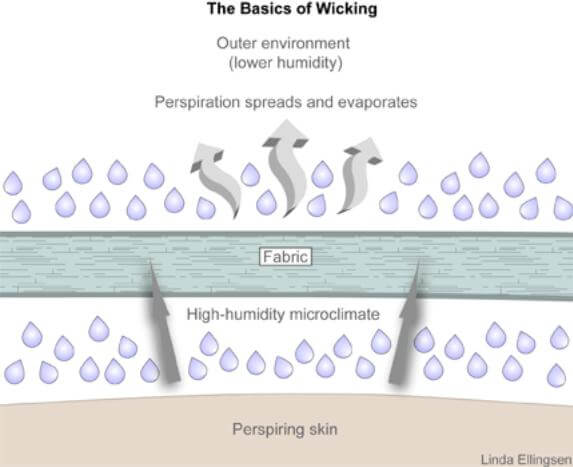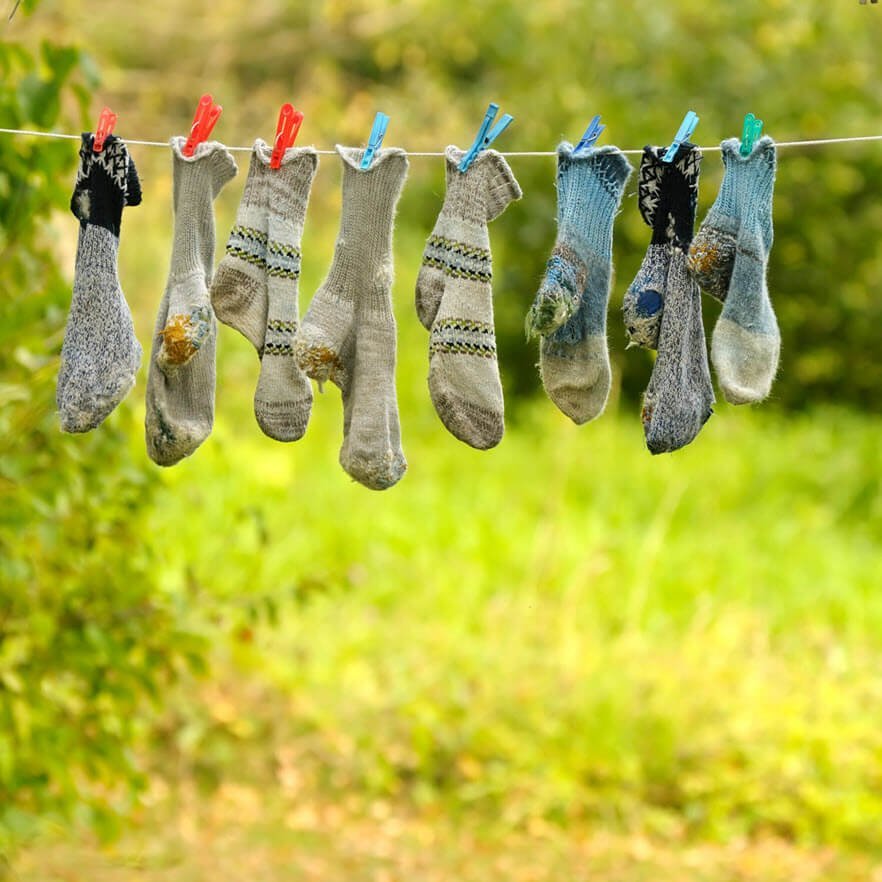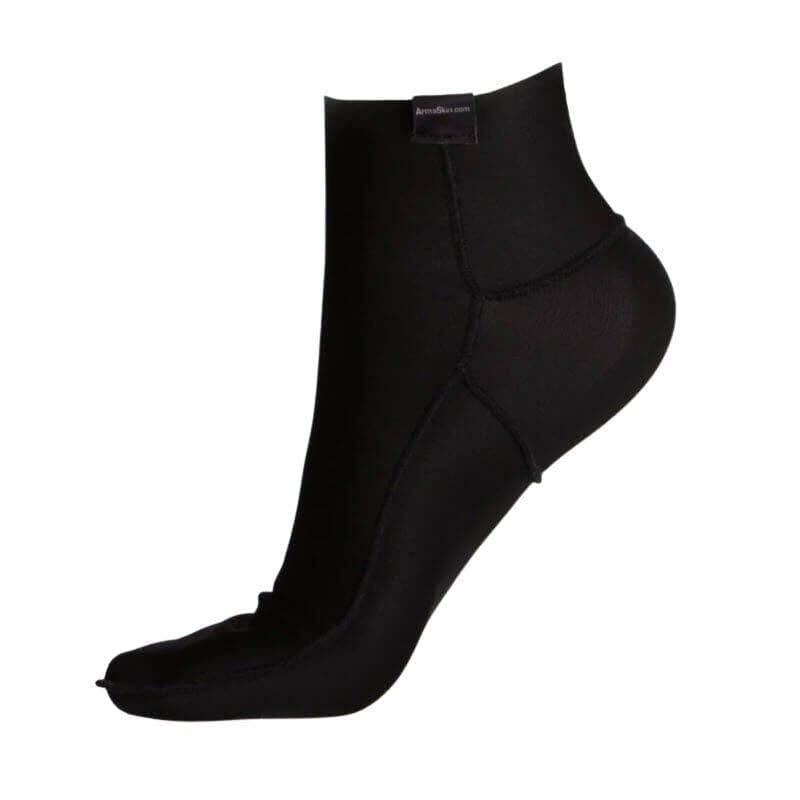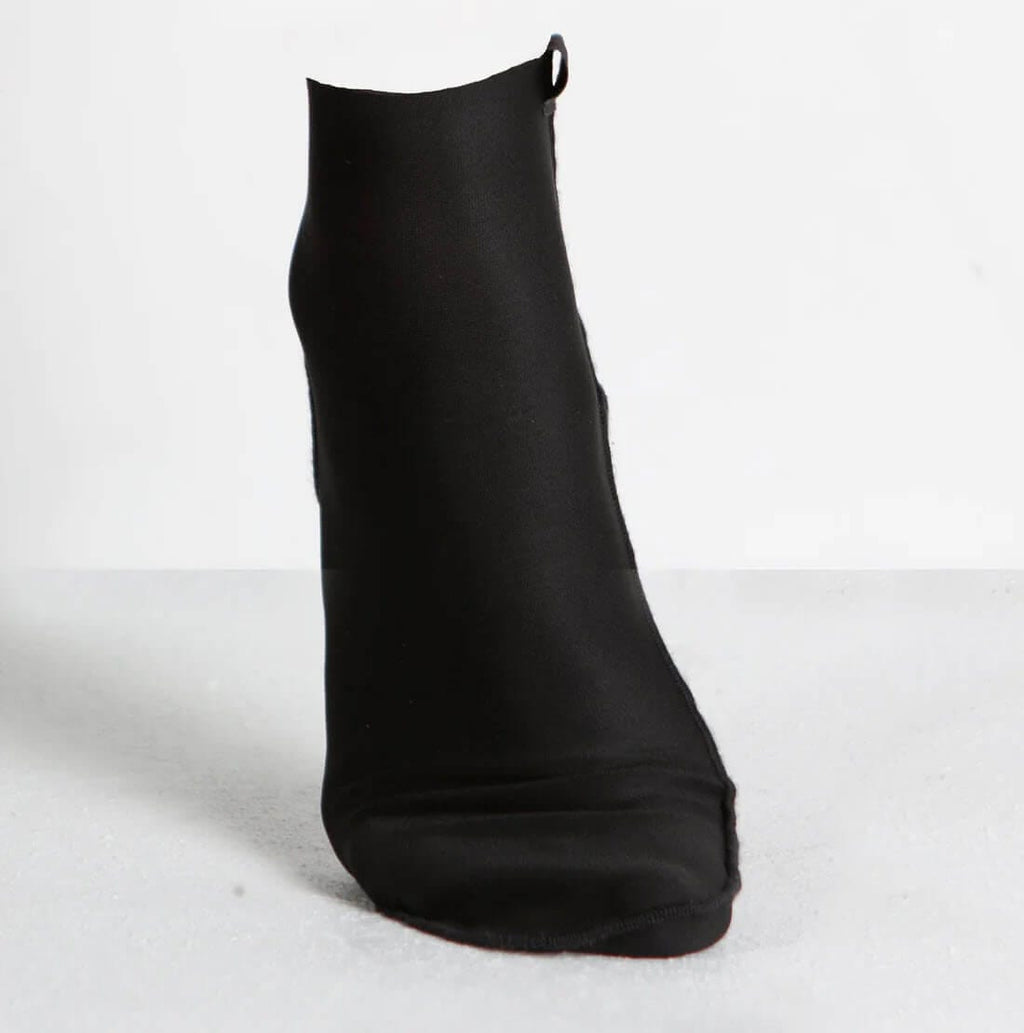Updated 26/03/2023: An important consideration in preventing blisters is your choice of sock. After all, they have direct contact with the foot skin. But how do you choose? Perhaps you already know you want moisture-wicking socks. But does that mean synthetic fibres, natural yarns, blends? I mean, it's all so confusing.
This may not provide you with all the answers you’re looking for! But it will go into a lot of detail, thanks to the research required for Dr Doug Richie’s and my 2023 literature review in the Journal of Athletic Training, Friction blisters on the feet: A critical assessment of current prevention strategies.
Why Moisture-Wicking Socks?
Intuitively, we understand socks have a moisture-management function. Firstly, nobody wants waterlogged macerated skin – it’s very fragile and can tear easily. But if we leave the problems around waterlogged skin to the side for this article, even moist skin is to be avoided as much as possible.
Moist skin exhibits a higher friction, and therefore larger shear deformation magnitudes in the soft tissues of the feet during locomotion. Conversely, dry skin exhibits a lower friction level. So, keeping the skin as dry as possible is one consideration in preventing blisters.
However, maintaining dry skin is a tough ask considering how much the feet perspire – especially when it’s hot and especially when we exercise. The soles of the feet (along with the palms of the hands) have the highest density of eccrine sweat glands on the body. It's well-known fact that the feet can produce in excess of a cup of sweat on an average day. That’s a lot of moisture for the sock to deal with. And still, that doesn’t account for hot/humid weather, heavy exercise, or environmental sources of moisture (like rain, dew, creek crossings, drink stations etc).
The initial goal of a sock is to absorb this moisture. However, the sheer volume of moisture encountered is large. Keeping the skin dry by absorption alone is an unrealistic expectation of any single material.
“The sum total of moisture potentially collecting in the shoe of an athlete during exercise will quickly exceed the absorptive capacity of any sock. Therefore, in order to keep moisture content at a minimum level on the surface of the foot during exercise, a sock must “move” moisture away to the shoe upper for evaporation. This process is known as wicking.”
What is "Moisture-Wicking"?
Moisture wicking is the process of moving moisture from the skin side of the sock, through to the outer side of the sock, so it can evaporate through the shoe upper. Their action relies on the ability to achieve a moisture gradient that encourages the transportation of moisture. Ventilated shoe uppers aid the effectiveness of moisture-wicking socks.
Moisture-wicking socks can be made of a single fibre type. More commonly, they are made from a combination of materials. We call these blends.

Moisture wicking is about moving moisture away from the skin.
Research Showing Sock Choice Matters
Let’s take a step back and look at some research that showed socks made a big difference to blister formation in a group of 35 long-distance runners . Fun fact, this is the only research that exists on blister incidence with different socks! The same researchers conducted a follow up study 3 years later that makes the combined results so interesting. Both studies compared 100% cotton socks to 100% acrylic socks that were identically constructed, in spite of the different fibres used.
- Study 1: Both socks were thick “densely padded” socks
- Study 2: Both socks were considered to be thin socks
The results:
- In the first study, predictably, the acrylic out-performed the cotton socks. Specifically, there were twice as many blisters, and blisters were three-times the size in the cotton socks.
- In the follow-up study, perhaps surprisingly, neither sock was better than the other. The acrylic was no longer protective against blisters.
The authors concluded that the superior blister prevention capacity of acrylic fibers over cotton fibers depends upon how thick and densely padded it is. They speculated that the moisture-wicking capacity of acrylic fibers to move moisture from the skin surface is enhanced by a dense padding. Conceptually, though, it may have also been attributed to some other mechanism related to their thickness.
A Quick Look at Fibres Used in Moisture-Wicking Socks
Cotton sock fibres: Cotton is the most hydrophilic fibre used in sock construction, for sure. It absorbs a lot of water and holds it against your skin! This is not good if you’re blister prone and taking part in activities where blisters are likely. It keeps the skin moist and clammy, which means a higher friction force.
Wool sock fibres: The next most absorbent fibre is wool. On its own, wool is not a great fibre for sock construction because of its hydrophilic nature. But Richie explains the premium Merino wool fibre is different. It is a common fibre used in specialist hiking sock construction for its thermal insulation properties.
“Compared with traditional wool, Merino wool has a much finer core diameter of each fibre, giving a softer feel and more air space for moisture movement. Merino wool has fewer tendencies for skin itch, which is common with regular wool socks and apparel. The finer fibre and natural airspaces created by Merino wool have lead manufacturers to claim that this fibre is superior to any synthetic fibre for insulation and wicking.”
Acrylic sock fibres: The blister research already mentioned compared acrylic to cotton socks. One shortcoming of acrylic is its poor insulation. On hot surfaces in summer months, acrylic fiber socks can conduct heat and be undersirable. Hollow core polyester or Coolmax socks may be preferred in these conditions.
Polyester sock fibres: An example of a polyester fibre is Coolmax. Coolmax polyester fibres have a four-channel configuration that increases surface area and moisture movement. The most popular synthetic fibers utilised in athletic hosiery are acrylic and polyester. Both acrylic and polyester fibers are hydrophobic and have superior wicking properties and reduced drying time than cotton.
Polypropylene sock fibres: Polypropylene fibres absorb next to no moisture at all.
A Complex Interplay of Factors
Fibres in sock manufacture are chosen according to the sock’s application. This may include thermal insulation, cushioning, durability, quick drying, the ability to maintain shape and moisture-management . Specifically relating to friction blisters, Baussan et al describe a complex interplay of several factors related to fibre and construction:
- Moisture regain
- Swelling properties
- Water transport
- Heat transfer
- Friction coefficient
The moisture absorptive capacity and surface properties of the sock fibers (hydrophobic or hydrophilic ) have a significant influence on a process known as wicking which is the movement of moisture from the skin to the outer side of the sock, to be evaporated through the shoe upper to the outside environment.
It is well-known that cotton has inferior moisture-wicking ability and is not suited to athletic socks:
- Cotton is a hydrophilic fiber which inhibits moisture-wicking ability .
- Cotton fibers absorb three times the moisture as synthetic acrylic fibers .
- Once wet, cotton has a ten-fold greater drying time compared to synthetic fibers.
Conversely, synthetic fibers such as acrylic, polypropylene and polyester are hydrophobic and facilitate wicking by transporting moisture along the fiber surfaces .
- A specialized polyester fiber known as Coolmax has a scalloped oval cross-sectional fiber geometry designed to increase its surface area by 20% to facilitate moisture transport .
- When comparing synthetic fibers, polyester fibers (Coolmax®) have a 15% faster drying time compared to acrylic fibers .
Moisture Regain
Moisture regain describes the ability of the sock material to attract and hold on to moisture. Hygroscopy describes the overall moisture absorption or adsorption capacity of the sock material. Absorption is the process by which a material takes up liquid through its surface or bulk. Adsorption is the process by which molecules or particles adhere to the surface of a material.
In terms of overall moisture regain:
- Wool is the most hygroscopic of all sock fibers, with an ability to carry between 30-50% of its weight in a moist environment .
- This is due to a greater capacity of wool for both absorption and adsorption of moisture within and along the surface of the fibers.
- Cotton fibers rank second in overall moisture regain after wool, retaining three times the moisture of acrylic and fourteen times the moisture of Coolmax .
Swelling
The absorption of water will cause swelling of sock fibers. The swelling of sock fibers reduces air space within the sock and thus inhibits the movement of moisture away from the skin surface.
- Cotton fibers will increase volume and swell by 44-49% when immersed in water.
Other research reveals that when moisture is applied:
- Cotton fibers swell 45%
- Wool fibers swell 35%
- Acrylic fibers swell 5%
Moisture Storage and Movement
Here are the results of a study that looked at the moisture storage and moisture movement properties of three common sock fiber materials .
- Polypropylene socks showed the best capacity to wick moisture from the inner side of the sock to the outer side.
- Woollen socks showed moderate wicking capacity which was slower than polypropylene.
- Polyamide (nylon) socks showed minimal wicking capacity with large amounts of moisture retained on the inner side of the sock.
In a field study of 37 military recruits wearing one of two sock types with a prototype military boots equipped with a GORE TEX membrane who were marching over a period of four consecutive days . The two sock conditions were:
- A 50% Merino wool / 33% polypropylene blend sock
- A 99% polypropylene sock
This study was designed to:
- Measure moisture content on the skin surface of the feet of the participants
- The moisture content retained by the socks after marching
- Participant perception of (by questionnaire):
- skin temperature
- overall dampness
- friction
- comfort
While blister incidence was not measured, results showed:
- The 50% Merino wool and 33% polypropylene blend sock was rated to be cooler, less damp, and more comfortable than a 99% polypropylene sock.
- The wool blend sock absorbed 2.9 times the moisture of the polypropylene sock.
The authors speculated that the superior moisture storage benefits of the wool blend sock outweighed the wicking capacity of a polypropylene sock inside a closed boot where moisture evaporation is compromised. Thus, to reduce moisture content on the skin surface, the absorptive capacity of a sock becomes most important when the footwear has resistance to vapor evaporation .
Fibre Density
As suggested by the research quoted at the beginning of this article, the density of fibers or construction of the sock may influence its moisture wicking capacity. Denser weave patterns or thicker padding may enhance moisture movement through the sock by reducing compaction and preserving air-space between the fiber networks.
Pressure Reduction
Fiber composition as well as the thickness or density of the fibers in the construction of the sock can influence pressure dissipation. Plantar shock attenuation provided over 72 hours by 5 types of athletic socks including cotton socks, wool cushion sole sports socks, acrylic cushion sole hiking socks, double layer cotton socks, and towelling cushion sole sports socks compared to barefoot.
- Only the wool cushion sole sports sock and the acrylic cushion sole hiking sock provided shock absorption compared to barefoot during walking.
- The cotton sock, double layer cotton sock and the towelling cushion sole sock did not.
Knits and Weaves
Now things get even more involved. These pieces of research looked at the knit or weave of the sock. There are no blister incidence studies here, just lab tests. And even then, it’s difficult to extrapolate the results directly to the real world. That’s because many use cotton, which isn’t used in modern athletic socks. Many measure only in a dry environment, which the in-shoe environment is definitely not! And some have inexplicably measured the dynamic coefficient of friction, when static COF is of far more significance in determining the magnitude of shear deformation and therefore friction blister formation.
Sock Construction and Coefficient of Friction
1) Terry versus Jersey
Sock construction can influence the coefficient of friction. These researchers looked at the dynamic COF of two common knitted structures used in athletic socks, namely:
- Terry - Terry fabric is knitted (not woven) and features distinct loops and soft piles of yarn on one side, with a smooth surface on the other side.
- Simple jersey, also known as flat-knit - Jersey fabric is also knitted and has a smooth surface on one side and piles on the other.
They found that terry construction generates less friction and absorbs more energy (shear absorption) than simple jersey or flat knit construction socks.
However:
- They only looked at cotton fiber construction was tested and this is not representative of the preferred fibers for today’s modern athletic socks.
- Only dynamic friction force was measured in this study which is less important than static friction force is when considering the pathomechanics of friction blisters in the feet.
- Friction was measured only in the dry condition of the sock fabrics which does not replicate the actual moist environment inside the shoe of an active individual. COF of any sock material is significantly affected by moisture . In fact, the COF can be increased by a factor of 2 when any sock fiber is exposed to high moisture .
2) Fine Wool versus Mid-Micron Wool versus Acrylic
Contradicting the above results, researchers measured both static and dynamic coefficient of friction at the sock-skin interface, comparing three fibers: fine wool, mid-micron wool and acrylic . In this study, fabric structure played a more significant role than sock fiber type in determining friction force and coefficient of friction at the sock-skin interface.
- Single jersey fabrics had the lowest coefficient of static and dynamic friction compared to half-terry and terry fabric structure.
- Acrylic fabrics consistently exhibited the highest frictional forces and coefficient of friction under wet and dry conditions.
- All fabrics and fibers showed increased friction with increased moisture.
- The most important effect of fiber was on the static frictional force and coefficient of static friction of damp fabrics, with fabrics composed of fine wool exhibiting lowest friction, and acrylic fabrics the highest.
- The authors also measured fabric deformation, a factor which increased friction force. Compared to fabrics with wool fibers, acrylic fabrics deformed more under weight when wet which could account for the difference in friction force between the two fibers.
- Also, half-terry and terry fabrics underwent more deformation than single jersey fabrics which also may explain the difference in friction force between these fabrics.
Other researchers also found that sock knit structure is more important than sock fiber composition in terms of friction force at the sock-skin interface . This study was limited to measuring dynamic friction force in the dry condition only, and found that:
- Terry knit structures consistently produced higher frictional force than their corresponding single knit jersey structures.
- The authors also found that higher density of the yarn in the terry fabrics, ie. loops per square inch, influenced frictional force with high density yarn having the highest friction force.
- The authors speculate that denser terry loops have more surface area to contact the skin and thus greater potential to resist skin sliding.
- Also, the experimental apparatus used in all three studies cited above resulted in compression of the terry piles by the friction measurement probe. As the piles compressed, an increased contact angle occurred between the probe and the sock interface increasing the sliding resistance or friction force. In other words, the terry piles appeared to undergo deformation with application of a friction probe which might be similar to what happens when a bone prominence contacts the terry loops of a sock inside the shoe.
- Finally, terry loops have a directional orientation which may increase friction with forward sliding while decreasing friction with backwards sliding. Indeed, Bussan found conflicting results with friction force in terry knit structures depending upon which direction the measurement apparatus was moved across the fabric.
Thermal conductivity
Finally, the thermal conductive properties of sock fibers are important considerations for blister prevention. Reducing or evacuating heat from the skin surface depends upon the thermal conductivity of the sock fibers. Cotton fibers have low thermal conductivity of 0,07W/m/K. Polyester has average thermal conductivity of 0.14W/m/K and polyamide (nylon) has a high thermal conductivity of 0.25 W/mK but has 6-fold greater moisture regain than polyester .
Conclusion
The function of moisture-wicking in socks is impacted by many variables. It's complicated. It's not clear-cut. While it is clear cotton is to be avoided, it is less clear if Merino wool is advantageous. Research doesn't clearly identify the perfect composition of sock for us to choose for optimal moisture-management whilst also being comfortable and other necessary factors. More recently, research on knits have added potentially useful information. However, consumers are unable to identify aspects such as terry or jersey knit construction as this information is not a part of sock packaging/labelling.
In spite of this, if you continue to get blisters in spite of your best efforts with moisture-wicking socks, rather than buy another pair, move on to a more targeted prevention for that particular anatomical site.
References
- Rushton R, Richie D. Friction blisters on the feet: A critical assessment of current prevention strategies. J Athl Train 2023. https://doi.org/10.4085/1062-6050-0341.22.
- Richie DH. Athletic Socks. In: Werd M, Knight E, editors. Athl. Footwear Orthoses Sport. Med., New York: Springer; 2010, p. 69–78. https://doi.org/10.1007/978-0-387-76416-0_7.
- Herring K, Richie D. Friction blisters and sock fiber composition. A double-blind study. J Am Podiatr Med Assoc 1990;80:63–71.
- Herring KM and Richie DH. Comparison of cotton and acrylic socks using a generic cushion sole design for runners. J Am Podiatr Med Assoc 1993;83:515–22.
- Baussan E, Bueno M, Rossi R, Derler S. Analysis of current running sock structures with regard to blister prevention. Text Res J 2013;83:836–48. https://doi.org/10.1177/0040517512461698.
- Rossi RM, Stämpfli R, Psikuta A, Rechsteiner I, Brühwiler PA. Transplanar and in-plane wicking effects in sock materials under pressure. Text Res J 2011;81:1549–58. https://doi.org/10.1177/0040517511413317.
- Onofrei E, Rocha AM, Catarino A. The Influence of Knitted Fabrics’ Structure on the Thermal and Moisture Management Properties. J Eng Fiber Fabr 2011;6:10–22. https://doi.org/10.1177/155892501100600403.
- Richie D. Therapeutic hosiery: an essential component of footwear for the pathologic foot. Pod Manag 2013:155–62.
- Bagherzadeh R, Gorji M, Latifi M, Payvandy P, Kong LX. Evolution of moisture management behavior of high-wicking 3D warp knitted spacer fabrics. Fibers Polym 2012;13:529–34. https://doi.org/10.1007/s12221-012-0529-6.
- Woolman MS, McGowan EB. Textiles: A handbook for the student and the consumer. New York: The Macmillan Company; 1946.
- Harris M. Handbook of Textile Fibers. Washington Harris Research Laboratories, Inc.; 1954.
- Rossi RM, Stämpfli R, Psikuta A, Rechsteiner I, Brü PA. Transplanar and in-plane wicking effects in sock materials under pressure n.d. https://doi.org/10.1177/0040517511413317.
- Veves A, Hay E, Boukon A. The use of specially padded hosiery in the painful rheumatoid foot. Foot 1992;1:175–7.
- Veves A, Masson E, Fernando D, Boulton A. Studies of experimental hosiery in diabetic neuropathic patients with high foot pressures. Diabet Med 1990;7:324–6. https://doi.org/10.1111/J.1464-5491.1990.TB01398.X.
- Veves A, Masson EA, Fernando DJS, Boulton AJM. Use of Experimental Padded Hosiery to Reduce Abnormal Foot Pressures in Diabetic Neuropathy. Diabetes Care 1989;12:653–5. https://doi.org/10.2337/DIACARE.12.9.653.
- Garrow AP, Van Schie CHM, Boulton AJM. Efficacy of multilayered hosiery in reducing in-shoe plantar foot pressure in high-risk patients with diabetes. Diabetes Care 2005;28:2001–6. https://doi.org/10.2337/diacare.28.8.2001.
- Donaghue VM, Sarnow MR, Giurini JM, Chrzan JS, Habershaw GM, Veves A. Longitudinal in-shoe foot pressure relief achieved by specially designed footwear in high risk diabetic patients. Diabetes Res Clin Pract 1996;31:109–14. https://doi.org/10.1016/0168-8227(96)01211-9.
- Howarth S, Rome K. A short-term study of shock-attenuation in different sock types. Foot 1996;6:5–9. https://doi.org/10.1016/S0958-2592(96)90052-8.
- Gwosdow AR, Stevens JC, Berglund LG, Stolwijk JAJ. Skin friction and fabric sensations in neutral and warm environments. Text Res J 1986;56:574–80. https://doi.org/10.1177/004051758605600909.
- Amber V, Lowe BJ, Niven BE, Laing RM, Wilson CA, Collie S. The effect of fiber type, yarn structure and fabric structure on the frictional characteristics of sock fabrics. Text Res J 2015;85:115–27. https://doi.org/10.1177/0040517514530029.
- DeBois I, Agarwal E, Kapoor A, Mathur K. Tribology of The Sock-Skin Interface -The Influence of Different Fabric Parameters On Sock Friction. Rev J Foot Ankle Res 2021. https://doi.org/10.21203/rs.3.rs-1018429/v1.
- Bogerd CP, Niedermann R, Brühwiler PA, Rossi RM. The effect of two sock fabrics on perception and physiological parameters associated with blister incidence: A field study. Ann Occup Hyg 2012;56:481–8. https://doi.org/10.1093/annhyg/mer127.








